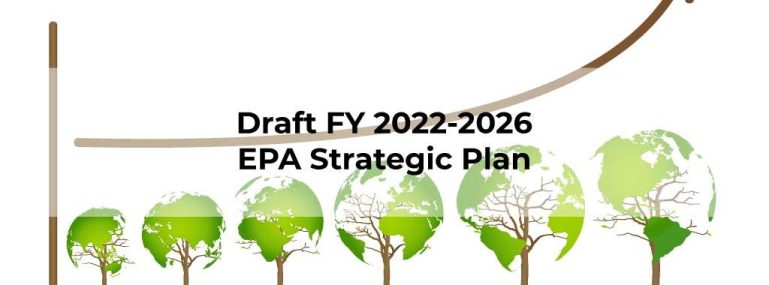The Draft FY 2022-2026 EPA Strategic Plan. 86 Fed. Reg. 54448. availability was announced by the U.S. Environmental Protection Agency (EPA), on October 1, 2021. EPA’s priorities and the roadmap for achieving its mission to protect human health and the environment is communicated by the draft Strategic Plan. Below are the goals with objectives outlined by the draft Strategic Plan.
- Goal 1: Climate Crisis tackling
- Goal 2: Advance Environmental Justice and Civil Rights by taking decisive action
- Goal 3: Environmental Laws enforcement and Compliance assurance
- Goal 4: Ensure Clean and Healthy Air for All Communities
- Goal 5: Ensure Clean and Safe Water for All Communities
- Goal 6: Safeguard and Revitalize Communities
- Goal 7: Ensure Safety of Chemicals for People and the Environment.
The EPA Strategic Plan has two objectives:
- Objective 1 – Chemical and pesticide insurance program. This will provide protection for the health of families, communities, and ecosystems against the risks posed by chemicals and pesticides. The programs are designed to achieve the following long-term goals:
- Completing at least eight high priority substance (HPS) Toxic Substances Control Act (TSCA) risk evaluations annually by September 30, 2026, compared with the fiscal year (FY) 2020 baseline of one.
- A 90 percent review of TSCA risk mitigation requirements for new chemicals by September 30, 2026, rather than the baseline of none for FY 2021
- As compared to the baseline of 36 percent for FY 2021, 40% of lead-based paint Renovation, Repair, and Painting (RRP) firm certifications are expected to expire by September 30, 2026
- By September 30, 2026, complete 78 pesticide registration reviews
- By September 30, 2026, to incorporate effects determinations or protections of federally threatened and endangered species into 90 percent of the risk assessments supporting pesticide registration decisions concerning new active ingredients, compared to 50 percent in FY 2020
- By September 30, 2026, 50 percent of the risk assessments supporting pesticide registration review decisions will consider federally threatened and endangered species, compared to 25 percent in FY 2020
- By September 30, 2026, to provide pesticide safety training to 20,000 farmworkers, as opposed to the average annual baseline of 11,000 farmworkers for FY 2018-2020.
- Objective 2 – Promote Pollution Prevention. With the intention of encouraging the adoption of pollution prevention practices and other stewardship practices that conserve natural resources, mitigate climate change, and enhance environmental sustainability. The following long-term objectives are included:
- A total of 1.5 million metric tons of carbon dioxide equivalent is expected to be reduced as a result of EPA pollution prevention grants by September 30, 2026
- A total of 2,300 products will be certified under EPA’s Safer Choice program, compared to the baseline of 1,950 products certified in FY 2021
According to the notice, the EPA is seeking comments from citizens, states, tribes, local governments, industry, academics, non-governmental organizations (NGOs), and all other interested parties. The deadline for comments is November 12, 2021.
Do you want to know more about how to get certified under the EPA’s Safer Choice Program, talk to one of the Compliance specialists today!





